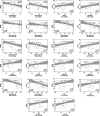Frequency-dependent alterations in functional connectivity in patients with Alzheimer's Disease spectrum disorders
- PMID: 38605859
- PMCID: PMC11007178
- DOI: 10.3389/fnagi.2024.1375836
Frequency-dependent alterations in functional connectivity in patients with Alzheimer's Disease spectrum disorders
Abstract
Background: In the spectrum of Alzheimer's Disease (AD) and related disorders, the resting-state functional magnetic resonance imaging (rs-fMRI) signals within the cerebral cortex may exhibit distinct characteristics across various frequency ranges. Nevertheless, this hypothesis has not yet been substantiated within the broader context of whole-brain functional connectivity. This study aims to explore potential modifications in degree centrality (DC) and voxel-mirrored homotopic connectivity (VMHC) among individuals with amnestic mild cognitive impairment (aMCI) and AD, while assessing whether these alterations differ across distinct frequency bands.
Methods: This investigation encompassed a total of 53 AD patients, 40 aMCI patients, and 40 healthy controls (HCs). DC and VMHC values were computed within three distinct frequency bands: classical (0.01-0.08 Hz), slow-4 (0.027-0.073 Hz), and slow-5 (0.01-0.027 Hz) for the three respective groups. To discern differences among these groups, ANOVA and subsequent post hoc two-sample t-tests were employed. Cognitive function assessment utilized the mini-mental state examination (MMSE) and Montreal Cognitive Assessment (MoCA). Pearson correlation analysis was applied to investigate the associations between MMSE and MoCA scores with DC and VMHC.
Results: Significant variations in degree centrality (DC) were observed among different groups across diverse frequency bands. The most notable differences were identified in the bilateral caudate nucleus (CN), bilateral medial superior frontal gyrus (mSFG), bilateral Lobule VIII of the cerebellar hemisphere (Lobule VIII), left precuneus (PCu), right Lobule VI of the cerebellar hemisphere (Lobule VI), and right Lobule IV and V of the cerebellar hemisphere (Lobule IV, V). Likewise, disparities in voxel-mirrored homotopic connectivity (VMHC) among groups were predominantly localized to the posterior cingulate gyrus (PCG) and Crus II of the cerebellar hemisphere (Crus II). Across the three frequency bands, the brain regions exhibiting significant differences in various parameters were most abundant in the slow-5 frequency band.
Conclusion: This study enhances our understanding of the pathological and physiological mechanisms associated with AD continuum. Moreover, it underscores the importance of researchers considering various frequency bands in their investigations of brain function.
Keywords: Alzheimer’s disease; amnestic mild cognitive impairment; degree centrality; resting-state functional magnetic resonance imaging; slow-5 frequency band; voxel-mirrored homotopic connectivity.
Copyright © 2024 Hu, Wang, Abdul, Tang, Feng, Mu, Ge, Liao and Ding.
Conflict of interest statement
The authors declare that the research was conducted in the absence of any commercial or financial relationships that could be construed as a potential conflict of interest.
Figures





Similar articles
-
Interhemispheric functional connectivity for Alzheimer's disease and amnestic mild cognitive impairment based on the triple network model.J Zhejiang Univ Sci B. 2018 Dec.;19(12):924-934. doi: 10.1631/jzus.B1800381. J Zhejiang Univ Sci B. 2018. PMID: 30507076 Free PMC article.
-
Frequency-Specific Abnormalities Of Functional Homotopy In Alcohol Dependence: A Resting-State Functional Magnetic Resonance Imaging Study.Neuropsychiatr Dis Treat. 2019 Nov 19;15:3231-3245. doi: 10.2147/NDT.S221010. eCollection 2019. Neuropsychiatr Dis Treat. 2019. PMID: 31819451 Free PMC article.
-
Exploring the Potential of Voxel-Mirrored Homotopic Connectivity (VMHC) and Regional Homogeneity (ReHo) in Understanding Cognitive Changes After Heart Transplantation.Biomedicines. 2025 Apr 3;13(4):873. doi: 10.3390/biomedicines13040873. Biomedicines. 2025. PMID: 40299406 Free PMC article.
-
Alterations of interhemispheric functional homotopic connectivity and corpus callosum microstructure in bulimia nervosa.Quant Imaging Med Surg. 2023 Oct 1;13(10):7077-7091. doi: 10.21037/qims-23-18. Epub 2023 Sep 19. Quant Imaging Med Surg. 2023. PMID: 37869275 Free PMC article.
-
Reduced homotopic interhemispheric connectivity in psychiatric disorders: evidence for both transdiagnostic and disorder specific features.Psychoradiology. 2022 Nov 24;2(4):129-145. doi: 10.1093/psyrad/kkac016. eCollection 2022 Dec. Psychoradiology. 2022. PMID: 38665271 Free PMC article. Review.
Cited by
-
Regional brain function study in patients with primary Sjögren's syndrome.Arthritis Res Ther. 2025 Apr 23;27(1):93. doi: 10.1186/s13075-025-03554-3. Arthritis Res Ther. 2025. PMID: 40270048 Free PMC article.
-
A comparative study of interhemispheric functional connectivity in patients with basal ganglia ischemic stroke.Front Aging Neurosci. 2024 Sep 25;16:1408685. doi: 10.3389/fnagi.2024.1408685. eCollection 2024. Front Aging Neurosci. 2024. PMID: 39385827 Free PMC article.
-
Resting-state functional magnetic resonance imaging study on cerebrovascular reactivity changes in the precuneus of Alzheimer's disease and mild cognitive impairment patients.Sci Rep. 2025 Jan 2;15(1):363. doi: 10.1038/s41598-024-82769-x. Sci Rep. 2025. PMID: 39747269 Free PMC article.
-
Frequency-dependent changes in the amplitude of low-frequency fluctuations in post stroke apathy: a resting-state fMRI study.Front Psychiatry. 2025 Feb 14;16:1458602. doi: 10.3389/fpsyt.2025.1458602. eCollection 2025. Front Psychiatry. 2025. PMID: 40027597 Free PMC article.
References
LinkOut - more resources
Full Text Sources

